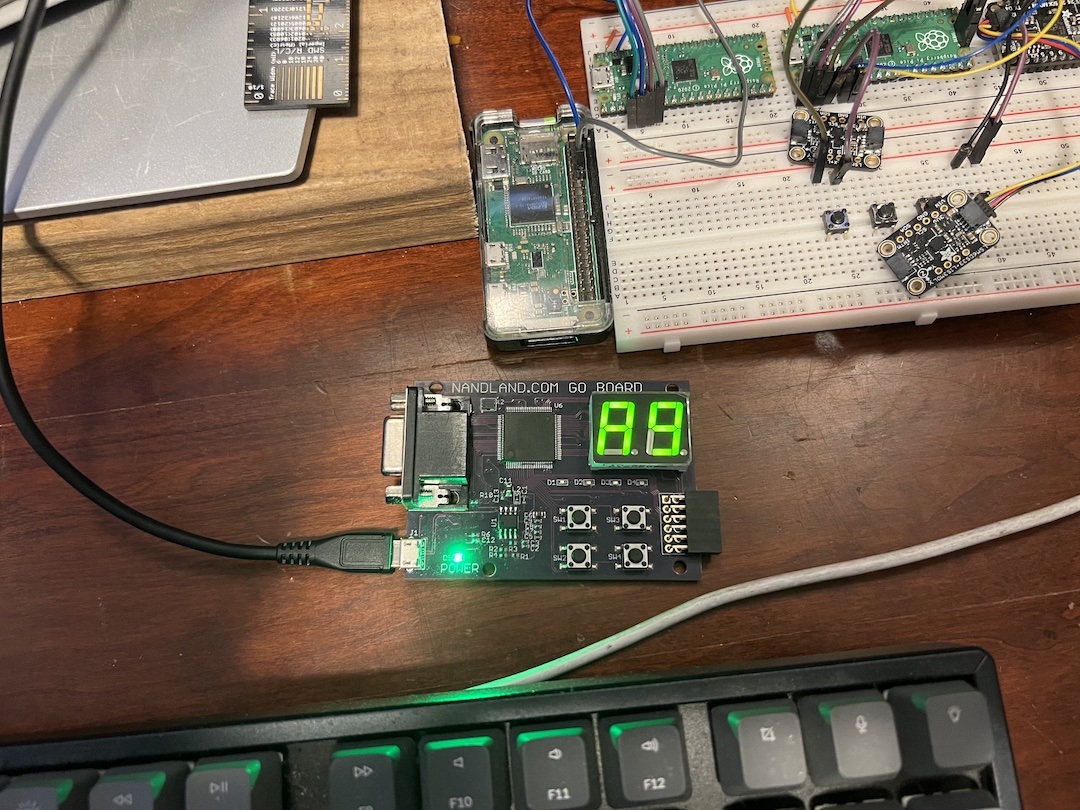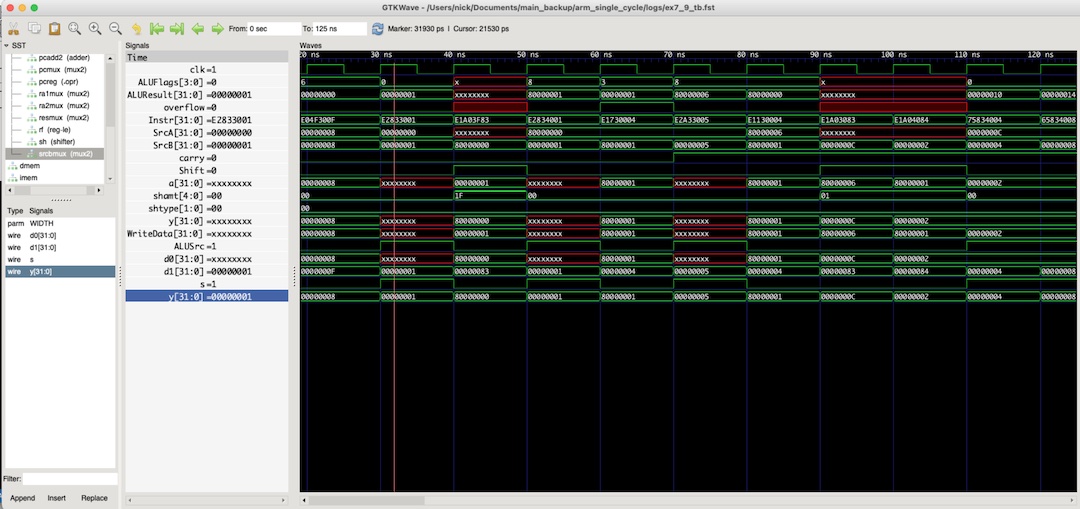This is a SystemVerilog project heavily based off the single cycle arm processor in the book: DD&CA ARM Edition
My goal is to have the three versions (single cycle / multi cycle / pipelined) of the ARM processor described in the DD&CA book working on a couple different fpga dev boards that I have.
- In single cycle dmem.sv I have to change the clock to negedge for simulation, i need to see if the fpga wants negedge or posedge
The main board that I have been using is a goboard from nandland.com. Nandland has a very affordable board to get started with fpga and a lot of great tutorials and hdl information. The synthesis and implementation tools im using with the goboard are from oss-cad-suite, they're open source, work with Makefiles and are very easy to learn. I have generated a bit-steam and programmed a de0nano board through quartus prime lite with the single cycle code as well, but I don't like to use windows as much as mac / linux, so the de0nano doesn't get used very much. Recently I've picked up an arty-a7 from digilent as well as a arty-z7 to practice learning Vivado & Vitus with. I have the arm single cycle working on the arty-a7 as well and will put the build files here.
The book says that a computer architecture is defined by its instruction set and architectural state. The architectural state for the ARM processor consistes of 16 32-bit registers and a status register. We're also using a 8-bit wide memory address to make use of the goboard block RAM and 32-bit wide mem data. If you look in the dmem.sv file you can see how to enable 32-bit addressing if you just want to test with it vs programming the goboard.
At the time of this writing we only have a few instructions and as I add more i'll try to remember to update this readme.
- ADD
- SUB
- AND
- ORR
- LDR
- STR
- B
I have a simple count program that I ported over to the arm after seeing Xark run it on his SystemVerilog version of Ben Eaters 8-bit CPU. It simply counts up in hex and displays on the goboard 7-segment displays. To build it just cd into the goboard directory, make, make prog:
nick@MacBook-Pro arm_single_cycle % cd goboard
nick@MacBook-Pro goboard % make
=== Synthesizing FPGA design ===
verilator --lint-only -sv --language 1800-2012 --trace-fst -v /Users/nick/.bin/oss-cad-suite/share/yosys/ice40/cells_sim.v -I../rtl -Wall -Wno-DECLFILENAME -DNO_ICE40_DEFAULT_ASSIGNMENTS --top-module cpusys_goboard ice40_config.vlt cpusys_goboard.sv goboard_7seg.sv ../rtl/adder.sv ../rtl/alu.sv ../rtl/arm.sv ../rtl/condcheck.sv ../rtl/condlogic.sv ../rtl/controller.sv ../rtl/cpu_main.sv ../rtl/datapath.sv ../rtl/decoder.sv ../rtl/dmem.sv ../rtl/extend.sv ../rtl/flopenr.sv ../rtl/flopr.sv ../rtl/imem.sv ../rtl/mux2.sv ../rtl/regfile.sv ../rtl/shifter.sv 2>&1 | tee logs/cpusys_goboard_verilator.log
yosys -e "no driver" -l logs/cpusys_goboard_yosys.log -q -p 'verilog_defines -DNO_ICE40_DEFAULT_ASSIGNMENTS ; read_verilog -sv -I../rtl cpusys_goboard.sv goboard_7seg.sv ../rtl/adder.sv ../rtl/alu.sv ../rtl/arm.sv ../rtl/condcheck.sv ../rtl/condlogic.sv ../rtl/controller.sv ../rtl/cpu_main.sv ../rtl/datapath.sv ../rtl/decoder.sv ../rtl/dmem.sv ../rtl/extend.sv ../rtl/flopenr.sv ../rtl/flopr.sv ../rtl/imem.sv ../rtl/mux2.sv ../rtl/regfile.sv ../rtl/shifter.sv ; synth_ice40 -device u -json cpusys_goboard.json'
=== Routing FPGA design ===
nextpnr-ice40 -l logs/cpusys_goboard_nextpnr.log -q --placer heap --promote-logic --opt-timing --hx1k --package vq100 --json cpusys_goboard.json --pcf goboard.pcf --asc cpusys_goboard.asc
icepack cpusys_goboard.asc cpusys_goboard.bin
=== Synthesis stats for cpusys_goboard on hx1k ===
Package: oss-cad-suite-darwin-arm64-20220729
Yosys 0.19+36 (git sha1 30a4218f5, aarch64-apple-darwin20.2-clang 10.0.0-4ubuntu1 -fPIC -Os)
nextpnr-ice40 -- Next Generation Place and Route (Version nextpnr-0.3-69-g1b54fa2a)
Info: Device utilisation:
Info: ICESTORM_LC: 573/ 1280 44%
Info: ICESTORM_RAM: 1/ 16 6%
Info: SB_IO: 20/ 112 17%
Info: SB_GB: 8/ 8 100%
Info: Max frequency for clock 'CLK$SB_IO_IN_$glb_clk': 215.42 MHz (PASS at 12.00 MHz)
nick@MacBook-Pro goboard % make prog
iceprog -d i:0x0403:0x6010 cpusys_goboard.bin
init..
cdone: high
reset..
cdone: low
flash ID: 0x20 0x20 0x11 0x00
file size: 32220
erase 64kB sector at 0x000000..
programming..
done.
reading..
VERIFY OK
cdone: high
Bye.
nick@MacBook-Pro goboard %
Afterwards your goboard should count: 
A bit on environment / flow.
every time I set this up again I always want to setup a raspberry pi for a development environment. But that is not how my own flow goes. My development flow works like this:
macbook w/tools: oss-cad-suite, vscode, arm cross compiler
build / develop on the mac, then either load directly off the mac onto fpga in case of the goboard OR you can build the bitmap and copy it to the pizero and flash off the pizero straight to the icezero in case of the icezero. Key point is to top trying to build a development environment on a raspberry pi every time you start this up again.
if you want to just test the assembler on the pi( this is a bad example, I typically dont do this, i use the cross compiler on the mac instead of running directly on a pi):
pi@raspberrypi:~ $ as -o arm_test_example_os.o arm_test_example_os.s
pi@raspberrypi:~ $ objdump -S arm_test_example_os.o
pi@raspberrypi:~ $ gcc -o arm_test_example_os arm_test_example_os.o
pi@raspberrypi:~ $ gdb -tui ./arm_test_example_os
-> in gdb:
-> b main
-> run
-> layout asm
-> layout reg
-> help x
-> x/4tb 0x0000000000400398 (print mem in bin)
gdb: https://jacobmossberg.se/posts/2017/01/17/use-gdb-on-arm-assembly-program.html
arm assembler: https://thinkingeek.com/2013/01/20/arm-assembler-raspberry-pi-chapter-6/
arm developer guide: https://developer.arm.com/documentation/dui0068/b/ARM-Instruction-Reference/ARM-general-data-processing-instructions/TST-and-TEQ
